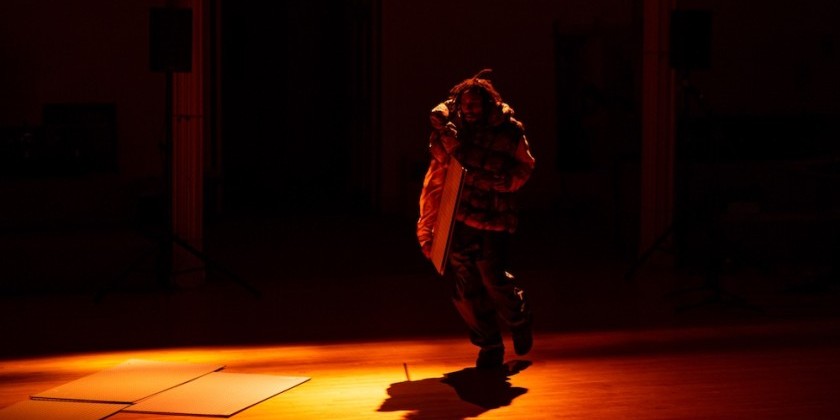Impressions of Mina Nishimura

Finding Sweetness in Butoh
Presented by Danspace Project / October 29-October 31
Celery of Everything / Choreography by Mina Nishimura
Performed by Sarah Lifson, Mina Nishimura, Connor Voss, and Christopher Williams
Music by Stephen Cooper and “Pachelbel’s Canon in D Major” by Johann Sebastian Bach
Costume and Props by Kota Yamazaki
Princess Cabbage / Choreography, Performance, and Drawings by Mina Nishimura
Music by Stephen Cooper / Lighting Design by Kathy Kaufman
Be nice! It’s something worth striving for, this outward presentation of compassion, thoughtfulness, and good manners. But beneath the smooth gloss of politesse that greases everyday interactions, our thoughts — the ones only available to us — can be rude, dark, and downright inappropriate. If spoken aloud, these foul musings would likely offend. Lucky for us, no one can read our mind yet.
Keeping it all to ourselves can cause dissonance between our public and private personas. Finding a way to physically manifest our jagged parts is one way to synchronize the disparity of what we say and do with how we feel.
Butoh, a theatrical dance style founded in Japan in the mid-twentieth century by Tatsumi Hijikata and Kazuo Ohno, celebrates the beauty in the ugly. Instead of sanding away the perverse, the awkward, and the deviant, it basks in them, creating a weird, gripping splendor where shoulders hunch, elbows jut, feet sickle, and fingers crimp into terrifying claws.

In her two-bill program at Danspace, choreographer Mina Nishimura takes the aesthetics of Butoh and overlays different moods to conceive of something fresh and unaffected. Her drawings litter the sanctuary of St. Marks Church; in between the two pieces, the audience shuffles around for an up-close look at her creepy, cute squiggles.
The first piece, Celery of Everything, features Nishimura with three performers (Sarah Lifson, Connor Voss, and Christopher Williams), none of whom appear completely at home in the Butoh vocabulary. They’re so game and polite that it doesn’t really matter. Sporting white t-shirts stamped with kitty-cat faces, the quartet writhes into barbed-wire sculptures. Each spouts some jabberwocky; most wittily, Connor Voss talks about a stye in his eye, and Nishimura opines on cats (a touch on the nose, perhaps). The effect could be absurd: In actuality, their winsome sincerity renders it adorable. Celery of Everything feels like Butoh for Millennials: A convivial community fetes their goofily weird quirks in GIF-worthy episodes.

Nishimura held back in Celery of Everything, content to let her dancers take front and center, but in Princess Cabbage, she flaunts the bravado skill of her small, discrete muscles. Her eyelids blink like a maddened coquette; her cheeks twitch like an agitated hummingbird’s wings. She chirps and she blathers. The spiky parts of Nishimura’s physique — elbows, shoulders, and knees — point and poke. Flickering impulses skitter across her body, which transforms her skin into a crust moved this way and that by the uncensored opinions roiling beneath.
It’s a far cry from the first Butoh performance where a young man copulated with a chicken onstage — rumor holds that the chicken died. But it seems heartening that Butoh can stretch to accommodate such diversity in viewpoints with Nishimura proving that sweetness and darkness make compelling bedfellows.
Share Your Audience Review. Your Words Are Valuable to Dance.
Are you going to see this show, or have you seen it? Share "your" review here on The Dance Enthusiast. Your words are valuable. They help artists, educate audiences, and support the dance field in general. There is no need to be a professional critic. Just click through to our Audience Review Section and you will have the option to write free-form, or answer our helpful Enthusiast Review Questionnaire, or if you feel creative, even write a haiku review. So join the conversation.














